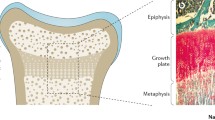Abstract
Rickets in a 3-year-old boy and his 1-year-old sister, both with alopecia, was cured by treatment with 50,000IU of vitamin D2 daily for 2 years and did not recur within 14 years after cessation of therapy. A diagnosis of vitamin-D-dependent rickets type II was made in these patients at the ages of 20 and 18 years based on the findings that 1,25-dihydroxyvitamin D3 [1,25 (OH)2D3] did not inhibit DNA biosynthesis in phytohaemagglutinin-stimulated lymphocytes and that cultured skin fibroblasts showed impaired nuclear uptake and normal cytosol binding of [3H] 1,25(OH)2D3. Surprisingly, the serum 1,25(OH)2D levels of these patients were high and their serum 24,25-dihydroxyvitamin D levels were low, although neither patient showed any symptoms except alopecia. The presence of vitamin D metabolite imbalances in the absence of rickets in these patients might be explained by differences in sensitivity to 1,25(OH)2D3 of bone formation and vitamin D metabolism. In addition, changes of sensitivity to treatment with vitamin D derivatives might be a consequence of differentiation of target cells. From the present findings, it is suggested that in this disease treatment with a sufficient dose of vitamin D derivatives should be initiated in the active phase of rickets.
Similar content being viewed by others
Abbreviations
- cyclic AMP:
-
adenosine 3′, 5′-cyclic monophosphate
- PHA:
-
phytohaemagglutinin
- 1,25 (OH)2D:
-
1,25-dihydroxyvitamin D
- 24,25 (OH)2D:
-
24,25-dihydroxyvitamin D
- 25 (OH)D:
-
25-hydroxyvitamin D
References
Abe E, Miyaura C, Sakagami H, Takeda M, Konno K, Yamazaki T, Yoshiki S, Suda T (1981) Differentiation of mouse myeloid leukemia cells induced by 1α, 25-dihydroxyvitamin D3. Proc Natl Acad Sci USA 78:4990–4994
Balsan S, Garabedian M, Liberman UA, Eil C, Bourdeau A, Guillozo H, Grimberg R, LeDeunff MJ, Liberherr M, Guimbaud P, Broyer M, Marx SJ (1983) Rickets and alopecia with resistance to 1,25 dihydroxyvitamin D: two different clinical courses with two different cellular defects. J Clin Endocrinol Metab 57:803–811
Balsan S, Garabedian M, Larchet M, Groski AM, Cournot G, Tau C, Bourdeau A, Silve C, Ricour C (1986) Long-term nocturnal calcium infusions can cure rickets and promote normal mineralization in hereditary resistance to 1,25-dihydroxyvitamin D. J Clin Invest 77:1661–1667
Clemens TL, Adams JS, Horiuchi N, Gilchrest BA, Cho H, Tsuchiya Y, Matsuo N, Suda T, Holick MF (1983) Interaction of 1,25-dihydroxyvitamin D3 with keratinocytes and fibroblasts from skin of a subject with vitamin-D-dependent rickets type II. J Clin Endocrinol Metab 56:824–830
Colston K, Feldman D (1982) 1,25-Dihydroxyvitamin D3 receptors and functions in cultured pig kidney cells (LLC PK1). J Biol Chem 257:2504–2508
Feldman D, Chen T, Cone C, Hirst M, Shani S, Benderli A, Hochberg Z (1982) Vitamin D resistance rickets with alopecia: cultured skin fibroblasts exhibit defective cytoplasmic receptor and unresponsiveness to 1,25-(OH)2D3. J Clin Endocrinol Metab 55:1020–1022
Fraher LJ, Karmali R, Hinde FRJ, Hendy GN, Jani H, Nicholson L, Grant D, O'Riordan JLH (1986) Vitamin-D-dependent rickets type II: extreme end organ resistance to 1,25-dihydroxyvitamin D3 in a patient without alopecia. Eur J Pediatr 145:389–395
Gamblin GT, Liberman UA, Eil C, Downs RW Jr, DeGrange DA, Marx SJ (1985) Vitamin-D-dependent rickets type II: defective induction of 25-hydroxyvitamin D3-24 hydroxylase by 1,25-dihydroxyvitamin D3 in cultured skin fibroblasts. J Clin Invest 75:954–960
Griffin JE, Zerwekh JE (1983) Impaired stimulation of 25-hydroxyvitamin D-24-hydroxylase in fibroblasts from a patient with vitamin D dependent rickets, type II: a form of receptor-positive resistance to 1,25-dihydroxyvitamin D3. J Clin Invest 72:1190–1199
Hirst MA, Hochman HJ, Felman D (1985) Vitamin D resistance and alopecia: a kindred with normal 1,25-dihydroxyvitamin D binding, but decreased receptor affinity for deoxyribonucleic acid. J Clin Endocrinol Metab 60:490–495
Hochberg Z, Benderli A, Levy J, Vardi P, Weisman Y, Chen T, Feldman D (1984) 1,25-Dihydroxyvitamin D resistance, rickets, and alopecia. Am J Med 77:805–811
Kurihara N, Ishizuka S, Kiyoki M, Haketa Y, Ikeda K, Kumegawa M (1985) Effects of 1,25-dihydroxyvitamin D3 on osteoblastic MC3T3-E1 cells. Endocrinology 118:940–947
Liberman UA, Samuel R, Halabe A, Kauli R, Edelstein S, Weisman Y, Papapoulos SE, Clemens TL, Fraher LJ, O'Riordan JLH (1980) End-organ resistance to 1,25-dihydroxycholecalciferol. Lancet I:504–507
Liberman UA, Eil D, Marx SJ (1983) Resistance to 1,25-dihydroxyvitamin D. Association with heterogeneous defects in cultured skin fibroblasts. J Clin Invest 71:192–200
Marx SJ, Liberman UA, Eil C, Degrange DE, Bliziotes MM (1985) Resistance to 1,25-dihydroxycholecalciferol in man and in other species. In: Norman AW, Schaefer K, Grigoleit H-G, Herrath DV (eds) Vitamin D: chemical, biochemical and clinical update. de Gruyter, New York, pp 107–116
Pike JW, Dokoh S, Haussler MR, Liberman UA, Marx SJ, Eil C (1984) Vitamin D3-resistant fibroblasts have immunoassayable 1,25-dihydroxyvitamin D3 receptors. Science 224:879–881
Sato T, Saito K, Takezawa T, Fujishima T, Iijima T, Kuninaka A, Yoshino H (1981) Urinary excretion of cyclic nucleotides and principal electrolytes in healthy humans of different ages. Clin Chim Acta 110:215–225
Takeda E, Kuroda Y, Saijo T, Toshima K, Naito E, Kobashi H, Iwakuni Y, Miyao M (1986) Rapid diagnosis of vitamin D-dependent rickets type II by use of phytohemagglutinin-stimulated lymphocytes. Clin Chim Acta 155:245–250
Takeda E, Kuroda Y, Saijo T, Naito E, Kobashi H, Yokota I, Miyao M (1987) 1α-Hydroxyvitamin D3 treatment of three patients with 1,25-dihydroxyvitamin D-receptor-defect rickets and alopecia. Pediatrics 80:97–101
Walton RJ, Bijvoet OLM (1975) Nomogram for derivation of renal threshold phosphate concentration. Lancet II:309–310
Author information
Authors and Affiliations
Rights and permissions
About this article
Cite this article
Takeda, E., Yokota, I., Kawakami, I. et al. Two siblings with vitamin-D-dependent rickets type II: No recurrence of rickets for 14 years after cessation of therapy. Eur J Pediatr 149, 54–57 (1989). https://doi.org/10.1007/BF02024336
Received:
Accepted:
Issue Date:
DOI: https://doi.org/10.1007/BF02024336




